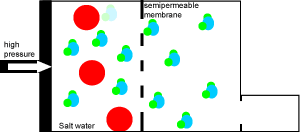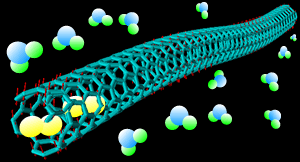
Currently, desalination plants use a method called reverse osmosis in order to purify sea water. This process requires high pressure and high energy consumption in order to push water through semipermeable membranes that block dissolved salts, as shown on the right. On average, it takes 1.5 to 2.5 kilowatt-hours of electricity to produce 1 cubic meter of fresh water.
Water flows unusually fast through carbon nanotubes often described as being equivalent to a garden hose being able to move as much water as a fire hydrant 10 times its size. This exceptional flow rate coupled with the ability to filter out salts and larger molecules, including bacteria and viruses, means that membranes can be made with carbon nanotubes that will reduce the energy used to purify water and speed up vital processes such as kidney dialysis.


